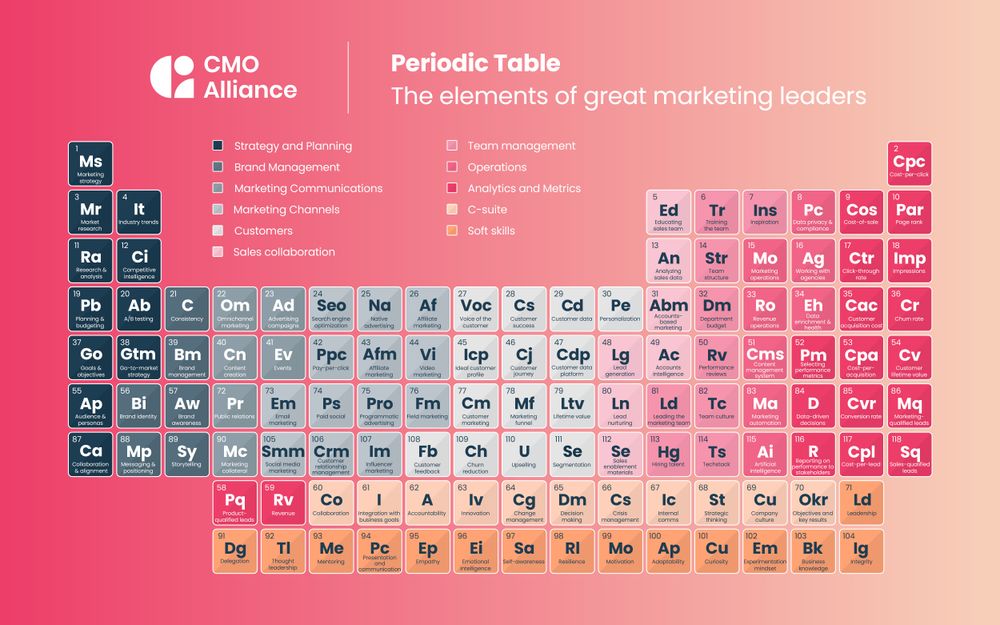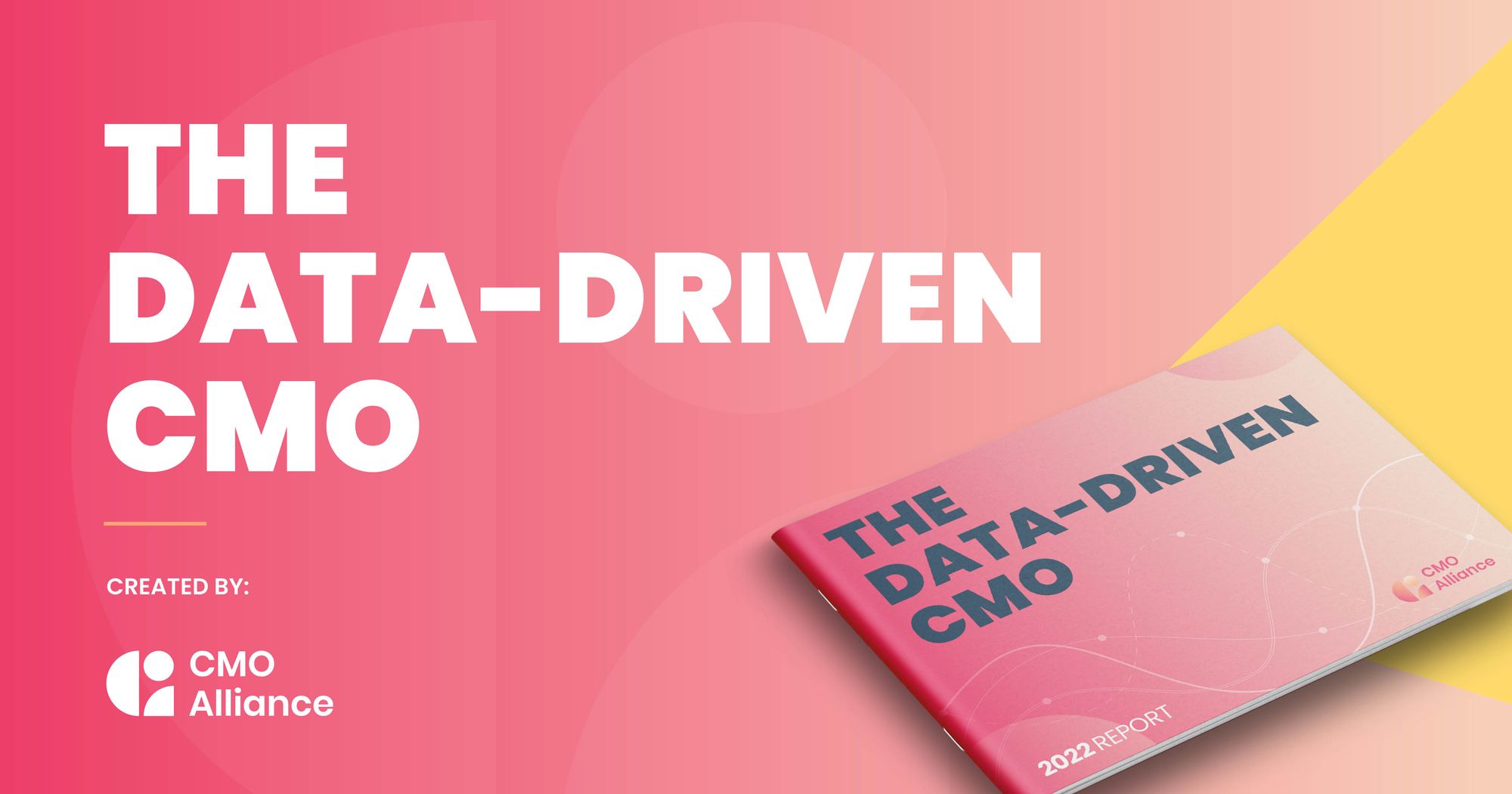One of the most fantastic things about the CMO role is how potentially diverse it can be. There are CMOs from all kinds of backgrounds, with all kinds of skill sets and experiences.
However, there are some constants that we've identified. Elements that make up the best CMOs. And so, we've created this periodic table of elements, where we detail everything that a great marketing leader needs to master.

Want the table in poster form? Download the files for free below. If you'd like to share it on any of your socials, we would appreciate the tag!
Strategy and Planning
Strategy and planning for marketing is CMO 101.
Ms 1: Marketing strategy: As a CMO, you play a vital role in developing, implementing, and refining a marketing strategy to maximize the effectiveness of your organization's marketing efforts.
Mr 3: Market research: Market research process helps you understand your target audience and determine the most effective marketing strategies to reach them. CMOs are responsible for overseeing and interpreting market research to make informed decisions about product development, pricing, and promotion.
Ra 11: Research & analysis: As a CMO, you rely on research and analysis to develop effective marketing strategies, evaluate the performance of existing campaigns, and make data-driven decisions.
Pb 19: Planning & budgeting: You need to be setting goals, defining marketing tactics, and allocating resources to achieve business objectives. To be most effective, you need to work closely with other stakeholders to develop marketing plans and budgets that align with overall company goals.
Go 37: Goals & objectives: A great CMO sets clear goals and objectives for marketing campaigns that ensure they align with the overall business strategy and contribute to the company's success.
Ap 55: Audience & personas: You have to understand your target audience and develop buyer personas, which are detailed descriptions of the ideal customer, to inform marketing strategies.
Ca 87: Collaboration & alignment: Marketing often needs to both support other departments and get the support you need from them in turn. You have to ensure that marketing efforts align with the overall business strategy and collaborate with other stakeholders to achieve shared objectives.
It 4: Industry trends: Industry trends refer to the current and emerging patterns and developments within a specific market. CMOs must stay up to date with industry trends to inform their marketing strategies and ensure their efforts are relevant and effective.
Ci 12: Competitive intelligence: CMOs use competitive intelligence to identify potential threats and opportunities and develop tactics to gain a competitive advantage.
Ab 20: A/B testing: A/B testing is essential to optimize marketing campaigns and improve their effectiveness.
Gtm 38: Go-to-market strategy: CMOs play a key role in developing go-to-market strategies that effectively reach the target audience and generate revenue for the company.

Brand Management
Your organization's brand is one of your ultimate responsibilities.
Bi 56: Brand identity: You have to oversee the development and maintenance of a company's brand identity to ensure it is consistent and effective in conveying the company's unique identity and values to its target audience.
Mp 88: Messaging & positioning: CMOs work to develop messaging and positioning strategies that effectively differentiate their company's products or services from those of competitors, and resonates with target customers.
C 21: Consistency: CMOs ensure consistency in branding across every customer touchpoint to build brand recognition, establish trust and credibility with customers, and reinforce the company's unique value proposition.
Bm 39: Brand management: You're responsible for developing brand management strategies that protect the brand's integrity, enhance its reputation, and increase its value.
Aw 57: Brand awareness: Brand awareness can be built through targeted marketing efforts, such as advertising, content marketing, and social media, to ensure your organization's brand is top-of-mind with its target audience.
Sy 89: Storytelling: Everyone loves a good story, and you can leverage storytelling techniques to create engaging and memorable brand experiences that resonate with customers and build brand loyalty.

Marketing communications
You need to know all about the different media and messaging to communicate with your target audience.
Om 22: Omnichannel marketing: You need to create a seamless and consistent experience for customers across all marketing channels, including email, social media, mobile apps, website, and physical stores. CMOs use omnichannel marketing to engage customers at every touchpoint in their buying journey and create a unified brand experience.
Cn 40: Content creation: Content is king/queen/non-hereditary head of state in marketing, and you need to oversee its creation to ensure the it aligns with the company's brand messaging and resonates with the target audience.
Pr 72: Public relations: PR is essential to increase brand awareness, manage crises, and establish your organization as a thought leader in its industry.
Mc 90: Marketing collateral: Marketing collateral covers all materials you produce that promote your organization's products and services, such as brochures, flyers, and sales sheets. You need to oversee the development of marketing collateral to ensure they align with the company's brand messaging and effectively communicates its unique value proposition.
Ad 23: Advertising campaigns: It's important to develop advertising campaigns to promote your organization's products or services across various channels, such as TV, radio, online, and social media.
Ev 41: Events: There are all sorts of events that can be used to promote your organization to your target audience, such as trade shows, product launches, or customer events. As a CMO, you oversee event planning and execution to ensure they align with the company's marketing strategy and effectively engage target audiences.

Marketing Channels
The number of channels for marketing is eternally increasing. As a CMO, you need to have a handle on all of them.
Em 73: Email marketing: The old workhorse of email marketing is still an important pillar of digital marketing. As a CMO, you can use it to nurture leads, build customer relationships, and drive revenue by promoting products or services through email newsletters, automated drip campaigns, and targeted promotions.
Smm 105: Social media marketing: While the specific social media platforms may vary (you might be on the big ones like Facebook, Instagram, Twitter, and LinkedIn, but don't forget rising stars like TikTok, or more niche ones specific to your audience), they are consistently an excellent way to engage with your target audience, promote its products or services, and build brand awareness. You need to develop social media marketing strategies to engage target audiences, build brand recognition and loyalty, and drive traffic and sales.
Seo 24: Search engine optimization: You have to ensure your organization's website and content are set up to rank effectively on search engine results pages, such as Google or Bing. CMOs oversee SEO strategies to increase organic search traffic, improve website visibility, and drive conversions.
Ppc 42: Pay-per-click: PPC campaigns can be highly effective at driving targeted traffic to a company's website, increasing brand awareness, and generating leads and sales.
Ps 74: Paid social: Similar to PPC, paid social campaigns can target specific audiences, increase brand recognition, and drive website traffic and sales.
Crm 106: Customer relationship management: Customer interactions need to be tracked, and an effective CRM is a perfect place to do so. When used properly, you can develop targeted marketing campaigns, improve customer engagement and loyalty, and drive revenue growth.
Na 25: Native advertising: This is all about positioning ads or sponsored content on a platform that makes it seem like it's not an ad at all, by matching the look and feel of the platform on which it appears. Once again, you can use it increase brand awareness and engagement, generate leads and sales, and improve customer relationships.
Af 26: Affiliate marketing: Find affiliates to promote a company's products or services in exchange for a commission for each sale or lead generated. Simple. It's great for expanding the company's reach, increasing brand awareness, and driving revenue growth.
Pro 75: Programmatic advertising: Most digital advertising will involve some form of programmatic advertising where automated software purchases and places digital ads in real-time, based on target audience demographics, interests, and behaviors.
Im 107: Influencer marketing: Like 'em or loath 'em, influencers are here to stay in marketing. Whether you're looking to work with big names, or looking to partner with "micro-influencers", they can play an important role in reaching and engaging with your audience.
Vi 44: Video marketing: Video is probably one of the most popular forms of content around. Creating engaging promotional videos, how-tos, and even just fun stuff can be great for reaching target audiences, increasing brand awareness, and driving website traffic and sales.
Fm 76: Field marketing: Get out into the field and meet your audience directly at events like trade shows, product launches, or street marketing campaigns. Your customers will be able to engage directly with your brand, forging stronger relationships and increasing brand awareness.

Customers
If you can find a way to do effective marketing without customers, we want to hear about it! For now, it's important for marketing leaders to know how best to understand their customers, and how to reach them with your marketing.
Fb 108: Customer feedback: The best relationships are built on two-way communication, which is why customer feedback is essential to your role. You need to collect and analyze customer feedback to understand customer needs and preferences, identify areas for improvement, and develop effective marketing strategies that meet their expectations.
Voc 27: Voice of the customer: Voice of the customer (VOC) is the term used to describe the collective feedback, preferences, and opinions of a company's customers. VOC data is powerful for informing marketing strategies, product development, and customer engagement initiatives.
Icp 45: Ideal customer profile: Who is your dream customer? Write that down and you're on your way to an ideal customer profile (ICP): a detailed description of the characteristics, behaviors, and needs of a company's ideal customer. You can use ICPs to identify target audiences, develop effective marketing strategies, and improve customer engagement and loyalty.
Cm 77: Customer marketing: One of the classic rules of business and marketing is that it's far more cost-efficient to retain a customer than attract a new one. That's where customer marketing comes in, to increase engagement, loyalty, and retention among existing customers. It's your chance to promote upselling and cross-selling opportunities, encourage referrals, and reduce churn.
Ch 109: Churn reduction: Keeping churn, or customer attrition, is essential to the longevity of many organizations. You need to use strategies and tactics that improve customer retention, increase revenue, and improve customer satisfaction.
Cs 28 Customer success: Most common in B2B SaaS, but growing in popularity in other industries, customer success is all about making sure your customers get maximum value out of your offerings. You can provide effective content, based on feedback, to proactively troubleshoot any issues that might block your customers route to success. All of which can improve customer satisfaction, reduce churn, and increase revenue.
Cj 46 Customer journey: You need to be able to map out the full journey customers might take when they interact with your brand. Every touch point, whether digital or otherwise, needs to be tracked and accounted for so you can see where your customers are coming from, and then optimize the process and their experiences.
Mf 78: Marketing funnel: Alongside a customer journey map, you need to develop a marketing funnel that moves prospects from initial awareness to consideration, evaluation, and decision-making. Each stage will require specific content and marketing strategies to achieve the best results.
U 110: Upselling: Customers are more likely to buy from brands they have already purchased from, but you need to encourage them with upselling marketing strategies to highlight your additional products and services, which will drive revenue and increase customer lifetime value.
Cd 29: Customer data: As a CMO, you have the opportunity to gather huge amounts of data on your customers: their demographics, behavior, preferences, and more. This data can then be used to develop more effective marketing strategies, identify the quality of leads, and help other departments, like product development.
Cdp 47: Customer data platform: Collecting all this customer data means you need a place to integrate it all from the different sources, manage it, and analyze it. Enter, your customer data platform (CDP). You can get a comprehensive view of customer behavior and preferences for developing your marketing strategies, and make it so you can easily share your findings.
Ltv 79: Lifetime value: It's important to keep track of how much revenue your customers appear to provide across the entire course of their relationship with your brand. These are customer lifetime values (CLV) and you can utilize knowledge of the types of customers with high to target similar customers and increase retention.
Se 111: Segmentation: While it would be great if you could personalize every single piece of marketing for every individual in your target audience. But that's not always possible, so it's much easier to use segmentation to split your audience into specific groups based on shared characteristics, such as demographics, behavior, and preferences, and then targetted using tailored marketing campaigns.
Pe 30: Personalization: Personalization has is now expected by the majority of consumers and B2B buyers, meaning you need to tailor your marketing messages to their specific needs and preferences. Doing so effectively can improve customer engagement, increase customer lifetime value, and build brand loyalty.

Sales collaboration
As the main revenue engine for many organizations, your ability to lead collaborations and support opportunities with the sales department is an essential aspect of being a CMO.
Lg 48: Lead generation: Lead generation is one of the most important functions of marketing in many businesses. However, you need to ensure you're generating the right leads that are most likely to become customers, and then provide content and messaging that's likely to encourage them to buy.
Ln 80: Lead nurturing: The process of moving leads along the customer journey is lead nurturing. As a CMO, you oversee nurturing strategies to keep leads engaged with the company, provide relevant content and information, and move them closer to a sale.
Se 112: Sales enablement materials: These are tools and resources that help sales teams effectively engage with customers and close deals, such as product information sheets, presentations, and case studies. Marketing is usually responsible for creating these materials, to ensure messaging is consistent and on brand.
Ed 5: Educating sales team: Marketing leaders play an important role in ensuring the sales team is up to date on the products or services you offer, your target audience, and marketing strategies. This information needs to be consistent and presented in ways that will help the sales team best achieve a sale.
An 13: Analyzing sales data: Win or lose on a sale, you need to know what happened. This information will help you gain insights into customer behavior, see where you can improve, and optimize marketing strategies to make sales more likely.
Abm 31: Accounts-based marketing: This is a huge deal in B2B organizations, where you target specific high-value accounts or customers with personalized marketing messages and content. This method can see a much greater RoI than traditional marketing strategies, and increase customer lifetime value. Be aware, however, that despite the name "accounts-based marketing", this is a company-wide strategy and needs to be coordinated with other departments to be effective.
Ac 49: Accounts intelligence: In order to do effective ABM, you need to know about your targets. CMOs use accounts intelligence to gain a better understanding of their target accounts, their needs and preferences, and how to effectively engage with them to increase the likelihood of sales.

Team management
Building and maintaining an effective marketing team is one of your most important duties as a CMO.
Ld 81: Leading the marketing team: This pretty broad element, we admit, but it's an important one! There's a lot that goes into leading the marketing team (see the elements below for more details), including providing direction, motivation, and guidance. You need to ensure they're properly trained and equipped with the tools and skills needed to provide maximum value to the organization.
Hg 113: Hiring talent: It's important that you're attracting the best people for your organization's roles. As a CMO, not only do you need to ensure you're hiring the right people for your own marketing team, you also need to present the brand and its recruitment messaging in a way that's going to attract top talent for other teams and departments.
Tr 6: Training the team: There are constantly new developments in marketing. You need to ensure your team has the knowledge and skills to adapt as a company grows and changes, produce new, creative marketing ideas, and adopt new tools and processes effectively.
Str 14: Team structure: The structure of your marketing teams needs to be set up in a way that maximizes the team members' effectiveness, and aligns with company goals.
Dm 32: Department budget: You'll need to manage the marketing department budget, including wages, L&D, techstack costs, and production costs for marketing campaigns.
Rv 50 Performance reviews: You need to be conducting regular performance reviews on the individual team members and the team as a whole, to make sure they're hitting their targets and objectives. Find out what's working for them, and what's not, and then adapt and improve. In larger organizations, it's unlikely you'll be able to sit down with every single team member, but you still need to have oversight and input on the process.
Tc 82: Team culture: What motivates and drives your team? What shared values and attitudes govern how they interact and collaborate? As a leader, it's up to you to develop and maintain a team culture that does all of that. Teams with strong cultures can be more innovative, motivated, and work together more effectively.
Ts 114: Techstack: As CMO, it's your duty to build and maintain an effective tech stack that supports your team in achieving their goals and objectives.
Ins 7: Inspiration: All leaders have to inspire their teams, to help drive them toward success and motivate them to excel. But as a CMO, you also need to provide inspiration that will foster and support creativity within the team.

Operations
Marketing doesn't just happen on its own, there are a lot of moving parts involved. As a CMO, you need to ensure all these moving parts fit together and work in concert effectively, whether it's personnel, tech and tools, or processes.
Mo 15: Marketing operations: Frequently known as "marketing ops" or "mar ops", these are all the processes and technologies used to plan, create and analyze your marketing. It's your responsibility to make sure everything works and fits together correctly, both within the marketing department, and how they interact with other departments.
Ro 33: Revenue operations: This is a sophisticated approach to aligning sales, marketing, and customer success. It involves ensuring you have tech and processes in place to maximize collaboration and organization. You'll need to work with other stakeholders to make sure these processes are appropriate for your respective teams, and that you're working towards shared objectives.
Cms 51: Content management system: Content is incredibly important to marketing, and having an effective content management system (CMS) is essential to make it easy for your team to create, manage, and distribute digital content.
Ma 83: Marketing automation: There are many tasks associated with marketing that basically equate to busy work. Many of these processes can be automated, freeing up your team to work on more interesting and valuable projects.
Ai 115: Artificial intelligence: Artificial intelligence (AI) or machine learning is quickly becoming moving from being a "nice-to-have" to a must-have in your tech stack. As a CMO, you need to explore its different applications and decide if they're right for your team and your organization's goals.
Pc 8: Data privacy & compliance: Marketing departments gather huge amounts of data, and that data needs to be collected, stored, and utilized in accordance with the correct ethical and legal standards.
Ag 16: Working with agencies: Outsourcing marketing services to external agencies can be incredibly effective, especially for things like PR or advertising, as they often rely on extensive resources and specialized skills. You'll need to decide what needs to be outsourced, select the right agencies, and ensure they're producing work to the standard you require.
Eh 34: Data enrichment & health: Raw data on its own is usually difficult to utilize, and often fragmented. By enriching your data to complete data sets, you'll have much more accurate and actionable data sets to work with.

Analytics and Metrics
In order to improve your marketing, you need to analyze and measure it, and in order to measure it effectively, you need to be using the right metrics.
Pm 52: Selecting performance metrics: First and foremost, you need to decide what are the most effective metrics to use to measure success for different projects. You want to avoid "vanity metrics" (i.e. metrics that only marketers care about) and ensure the metrics you use show the real impact you and your team are having on your organization.
D 84: Data-driven decisions: You might trust your gut, but others will trust it if you have the data to back up your choices. This is particularly important when you need to justify decisions to internal stakeholders.
R 116: Reporting on performance to stakeholders: Performance needs to be reported on at regular intervals to internal stakeholders, and you need to be able to explain the how and why of what's happening in a way that makes sense to others. You'll have to show the real impact your efforts are having on the organization's bottom line.
Cos 9 Cost of Sale: Cost of Sale (CoS) is a key metric for CMOs as it allows you to measure the efficiency of your marketing. Ideally, you want it to be as low as possible. It includes everything related to the sale, so the cost of the marketing materials that drove the sale, the cost of producing the actual products and getting them to the customer, and the wages of all the people involved need to be considered.
Ctr 17: Click-through rate: Click-through rate (CTR) is an important internal metric for marketing teams, as it allows you to directly measure the success of content and advertisements. It's particularly effective for A/B tests, so you can try out different copy, imagery, CTAs, and button positions.
Cac 35: Customer acquisition cost: CaC is largely similar to CoS, but focuses more on the marketing and sales aspect, rather than involving things like the cost of delivery.
Cpa 53: Cost-per-acquisition: This is CaC applied on a large scale, as you calculate the return on investment for your marketing and sales activities across all the deals made at the organization.
Cvr 85: Conversion rate: You'll rarely release a piece of content or marketing where you aren't aiming for the target audience to do something with it. This is obvious when you're trying to directly drive sales, but conversion rates also cover things like getting people to sign up to a newsletter, RSVP to an event, or book a demo. Conversion rates, unless they're directly tied to revenue, tend to work best as an internal metric for marketing teams to track, not as one to be discussed with other departments except when necessary.
Cpl 117 Cost-per-lead: If you're generating leads, you have to track the cost-per-lead (CPL) and work to get it as low as possible, so you can make the process as cost-efficient as possible.
Cpc 2 Cost-per-click: If you're doing any kind of digital performance marketing, like PPC ads or paid socials, you have to track the cost of each click to calculate the effectiveness of your spending.
Par 10: Page rank: Your page rank is how high up a search engine results page (SERP) on platforms like Google or Bing your website and content appears. Ideally, you want it to be as high as possible. You can move the needle on this with the right SEO tactics.
Imp 18: Impressions: This is the number of times an ad or piece of content is viewed. This can be useful to track the reach and exposure of your marketing, but if you have high impressions and low conversions or sales, then it's just a vanity metric.
Cr 36: Churn rate: This is an essential metric to track if you have any kind of subscription model or rely on long-term partnerships, as this tracks the rate of customers that are ceasing business with you. You want the rate to be as low as possible. If it's too high, then you need to work on your customer success and retention strategies.
Cv 54: Customer lifetime value: This is the total value a customer generates for a company over the course of their relationship. It's important as it allows you to identify the profitability of pursuing certain types of customer.
Mq 86: Marketing-qualified leads: Marketing-qualified leads (MQLs) are leads that have shown enough interest that they are worth focusing on with a lead nurturing campaign. They're the most likely to respond positively to these activities and are most likely to become...
Sq 118 Sales-qualified leads: Sales-qualified leads (SQLs) are leads that have reached the point where they're ready to be sent over to sales. This is one of the most important metric for CMOs with lead generation as a main duty, as SQLs are the most likely to become customers.
Pq 58: Product-qualified leads: Product-qualified leads (PQLs) are leads that have been identified as being prime customers for your products. This can be incredibly effective in B2B marketing. Identifying them often involves dedicated product marketers and developers coordinating.
Rv 59 Revenue: In modern business, when you get right down to it, this is the only metric that really matters - how much revenue are you driving with marketing? In order to really measure this, you'll need to be tracking every single way your audience interacts with your marketing, and how much of an influence it had in getting them to the point of sale.

C-suite
While you might lead the marketing team, you're a member of the C-suite team, and how you navigate it is important to your success as a CMO.
Co 60: Collaboration: Marketing is required to support and receive input from almost every department, so it's important that you're able to collaborate effectively with their C-suite representatives. After all, if you can't collaborate with them, how can you expect your teams to do so? It's essential for ensuring you understand other departments, their goals, and how you can work together to reach your business goals.
I 61: Integration with business goals: You need to ensure your marketing activities are aligned with the business goals of different departments to ensure everyone is working effectively together.
A 62: Accountability: You must be accountable for the performance of marketing. By setting clear objectives, tracking performance metrics, and reporting results to stakeholders, you can demonstrate the value of marketing efforts and make sure you have support in the future.
Iv 63: Innovation: You'll need to keep the C-suite up-to-date on new developments that might impact the business, the new things you're bringing to the table, and explain why they're important to internal stakeholders.
Cg 64: Change management: Marketing is constantly evolving and changing, and you'll need to manage that process. You need to make sure your team (both the marketing deparmtent, and the C-suite) can adapt to new technologies, industry trends, and changes in the business landscape.
Dm 65: Decision making: You need to be capable of making and justifying decisions that impact other members of the C-suite.
Cs 66: Crisis management: In an ideal world you might not ever need this skill, but at the same time you need to be prepared to work with the C-suite to manage your organization's reputation, mitigate risks, and respond to unexpected crises. It can be worthwhile to develop contingency plans with stakeholders so that you're prepared for when something negative happens.
Ic 67: Internal communications: As a CMO, you aren't just marketing externally, you'll also likely be in charge of the internal communications for the company, helping developing the C-suite's messaging on developments and issues to be share with the rest of the organization.
St 68: Strategic thinking: You need to display your keen mind for marketing strategy to earn the trust of the C-suite, while also being able to explain your thinking behind strategies in a way that's clear and shows how they align with your organization's goals.
Cu 69: Company culture: Developing an effective company culture can be incredibly important to foster innovation, attract the best talent, and in general keep employees motivated. As a CMO, you need to work with the rest of the C-suite to develop a culture that is inclusive and effective for all aspects of the organization.
Okr 70: Objectives and key results: Objectives and key results (OKRs) are all about setting clear, measurable objectives and tracking performance against key results. To get the best effect from them, they should be established and shared across the entire business, which means you'll need to work with the rest of the C-Suite to set them up.

Soft skills
Marketing leadership in the C-suite isn't just about being a master marketer. There are traits and skills you need to succeed that need to be developed alongside your marketing know-how.
Ld 71: Leadership: Leadership is one of the most important skills/traits for a successful CMO. You need to be able to inspire and motivate not just your own department, but potentially others if you're in charge of internal comms.
Dg 91: Delegation: You might have mastered marketing to get to the CMO role, but at the end of the day you can't do EVERYTHING. It's important that you're able to effectively delegate responsibilities among your team so you can focus on the important stuff.
Tl 92: Thought leadership: As a CMO, it's likely you'll be a public face for your organizations, meaning it's important to position yourself as a thoughtleader on your industry by regularly creating and publishing thought leadership content. But you can also work on building up your personal brand by producing thought leadership content on the CMO role and the marketing industry as a whole as a way to generate bigger and better opportunities for your career.
Me 93: Mentoring: As the most senior marketer in your organization, it's likely you'll have a large selection of marketers in your charge of different levels of experience and ability, all looking for guidance from you. There's also likely to be a large number of people outside your organization seeking advice and mentorship. Mentoring offers CMOs a great opportunity to mold and develop their own teams, and have a hand in developing the next generation of marketing leaders and drive business growth.
Pc 94: Presentation and communication: As a CMO, you'll likely have to give regular presentations and talks both externally, as part of marketing and thought leadership activities, and internally, to different teams and stakeholders. This means it's essential that you have effective presentation and communication skills.
Ep 95: Empathy: Empathy is pretty important in marketing: you need to understand your customers' needs and challenges in order to create the right messages to reach them. But as a CMO, you also need empathy in order to effectively manage and guide your team, and understand the priorities of other departments and stakeholders so you can work with them effectively.
Ei 96: Emotional intelligence: As a CMO you need strong relationships with team members, understand their motivations, and lead effectively.
Sa 97: Self-awareness: You need to be able to recognize your weaknesses so you can identify effective solutions to fill those gaps.
Rl 98: Resilience: The world can throw a lot of curveballs at you: personal, professional, or big events in society. As a CMO, you need to be able to weather these challenges.
Mo 99: Motivation: If you can't stay motivated, how can you expect your team to do so? The CMO role is challenging, and to get the rewards you need to have the drive and ambition to overcome your obstacles.
Ap 100: Adaptability: The marketing world is constantly changing, and you need to be able to adapt to changes, both internal and external, that can impact your role.
Cu 101: Curiosity: You need to be proactive in exploring new solutions and trends that you need to be on top of for your organization, but also you need to be curious to stay creative! You never know where inspiration may come from, so absorb culture, both highbrow and lowbrow, like a sponge!
Em 102: Experimentation mindset: You need to be willing to test and experiment with pretty much everything as a CMO. New marketing strategies, new campaign ideas, new tech, new processes, and more.
Bk 103: Business knowledge: You might be a marketing maestro, but as a CMO, you need an in-depth understanding of how businesses function to succeed. You need to understand what really drives business growth, and the functions within the business that does so.
Ig 104: Integrity: CMOs have a lot of responsibility, so it's important that you can show you have the integrity to be able to do so. Furthermore, as a public face of the company, your actions can impact the organization's reputation as a whole. Furthermore, it's likely you'll be heavily involved in any work at the business that relates to important topics like environmental sustainability and Diversity, Equity, and Inclusitivity programs.
Looking to hone any of these elements? The CMO Alliance Community Slack channel is the perfect place to engage with a global network of CMOs and marketing leaders.




 Follow us on LinkedIn
Follow us on LinkedIn




